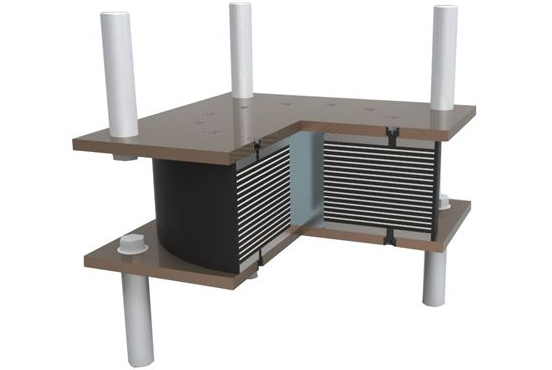A lead rubber bearing (LRB) is a type of seismic isolation device used in construction to absorb and dissipate the energy of earthquakes. The device consists of layers of rubber and steel, with a lead core that allows for controlled movement during seismic events. This technology has been used for decades in high-risk seismic areas to help reduce the risk of damage to buildings and infrastructure.

Seismic isolation is a method of protecting buildings from the destructive effects of earthquakes. It involves creating a flexible base between the building and the ground, which allows the building to move independently of the ground during an earthquake. This reduces the amount of energy that is transferred to the building, which in turn reduces the risk of damage.
The LRB is a type of seismic isolation device that is designed to provide a high degree of flexibility and stability. It consists of alternating layers of rubber and steel, with a lead core that allows for controlled movement during seismic events. The rubber layers provide the flexibility needed to absorb the energy of an earthquake, while the steel layers provide the stability needed to support the weight of the building.
The lead core of the LRB is the key to its effectiveness. The lead is a dense and malleable material that allows the device to move in a controlled manner during an earthquake. The lead core is encased in layers of rubber and steel, which provide additional support and flexibility. The result is a device that can absorb and dissipate a significant amount of energy during an earthquake, while also providing a stable base for the building.
The LRB is typically installed between the foundation of the building and the superstructure. The device is designed to allow the building to move in a controlled manner during an earthquake, while also providing a stable base for the building. This helps to reduce the risk of damage to the building and its contents, as well as the risk of injury to occupants.
LRBs are used in a variety of structures, including bridges, buildings, and other infrastructure. They are particularly useful in areas with high seismic activity, such as California, Japan, and New Zealand. LRBs have been used in a number of high-profile projects, including the San Francisco-Oakland Bay Bridge and the Taipei 101 skyscraper.
One of the key advantages of LRBs is their ability to provide a high level of seismic protection while also allowing for a high degree of design flexibility. LRBs can be customized to meet the specific needs of a building or structure, and can be designed to accommodate a wide range of loads and seismic events. This makes them a highly versatile and effective solution for seismic protection.
Another advantage of LRBs is their ease of installation. The devices can be installed relatively quickly and easily, without the need for extensive modifications to the building or structure. This helps to minimize disruption to building occupants and reduce the overall cost of the installation.
Despite their many advantages, LRBs are not without their limitations. One of the primary limitations of LRBs is their susceptibility to fatigue over time. The repeated cycles of loading and unloading during seismic events can cause the rubber layers to degrade over time, reducing the effectiveness of the device. This can be mitigated through regular inspection and maintenance, but it is important to be aware of this limitation when considering the use of LRBs.
In conclusion, lead rubber bearings are an effective and versatile solution for seismic protection in high-risk areas. They provide a high degree of flexibility and stability, allowing buildings and other structures to move in a controlled manner during seismic events. LRBs are easy to install and can be customized to meet the specific needs of a building or structure. However, it is important to be aware of their limitations, particularly their susceptibility to fatigue over time.
If you want to know more information about lead rubber bearings ( LRB ), please contact us. We will provide professional answers.